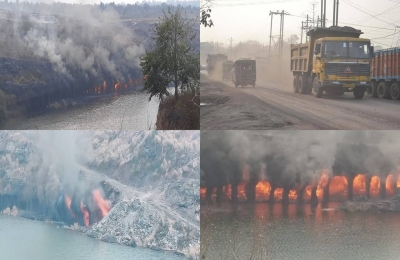Noxious air has cut Jharkhand's life expectancy by 4.4 years: Experts
By IANS | Published: October 22, 2022 01:06 PM2022-10-22T13:06:04+5:302022-10-22T13:15:07+5:30
Ranchi, Oct 22 The image of 'Jharkhand' that emerges in one's mind, considering its name, is that of ...

Noxious air has cut Jharkhand's life expectancy by 4.4 years: Experts
Ranchi, Oct 22 The image of 'Jharkhand' that emerges in one's mind, considering its name, is that of a state surrounded by forests and shrubs which also gives an impression that the air quality in the state would be good. But the ground reality is completely different and the Air Quality Index (AQI) figures testify the same.
In Jharkhand, the average AQI at 3 p.m. on October 1 was recorded at 182, while the average Air Quality Index for the entire country during the same period was 136. The worst AQI was recorded at 252 on October 20 at 8.37 p.m., while the best AQI was recorded at 112 at 2.35 p.m. on October 21.
Air in almost all the major cities of the state is polluted. In January 2020, a report by Greenpeace India termed Jharkhand's Jharia city as the most polluted city in the country.
In the report, prepared after the analysis of particulate matter (PM10) data in the atmosphere in 287 cities across the country, Dhanbad was ranked as the second most polluted city in the country.
Jharia and Dhanbad are the largest coal producing regions of the country. Even, Dhanbad is called the coal capital of the country.
According to a study by Legal Initiative for Forest and Environment (LIFE), the life expectancy of people of Dhanbad has dropped by 7.3 years due to air pollution.
Similarly, as per the data released by Epic, an institution of the Chicago University, the air pollution reduces the life expectancy of people in the state by an average of 4.4 years. According to this report, Jharkhand is at number eight among the most polluted states of India.
The Central Pollution Control Board (CPCB) after studying the data from 2015 to 2019 had found that the air quality in 124 cities of the country is 'hazardous'. Dhanbad, Ranchi, Ramgarh and Jamshedpur cities of Jharkhand were also included in this list of 124 cities.
In October, the Jharkhand State Pollution Control Board has launched Star Rating Programme to make common people aware of the pollution spreading from industrial units.
Under the programme, launched in partnership with EPIC India at the University of Chicago Trust, industrial units are being rated on the basis of air pollutants being emitted by them and the control measures these units are taking to deal with it. All details are being released on a dedicated website.
In total, details of 68 industrial units of Jharkhand are recorded on the website.
According to the website, in September, 36 out of these 68 industrial units were given 1 star rating, keeping them in the red or dangerous category. There are only 23 industrial units which have been given 5 star rating for pollution control measures. Similarly, five industries got 4 star rating, three industries received 3 star rating and one industry was rated 2 star.
The most air polluting industries include Amalgam Steel located in Seraikela-Kharsawan district, BK Steel Industries, Bihar Sponge Iron Limited, Jamshedpur Chlorochem, ACC Limited of West Singhbhum, Jamshedpur Chemicals and Minerals in East Singhbhum, Ankur Biochem Pvt. Ltd., Brahmaputra Metallics at Ramgarh, Inland Power, Jai Durga Iron, Kameshwar Alloys & Steel, Grasim Industries at Rehla, Palamu, and others.
Ranchi-based environmentalist Nitish Priyadarshi says that the pollution control board describes the air of Ranchi urban area as favourable for health, but if the air quality here is evaluated on the basis particulate matter present in the air, it can be seen that even while staying indoor the air people inhale here is as harmful as about 10 cigarettes.
Prof Gurdeep Singh, former head of the Department of Environmental Engineering, IIT-ISM, Dhanbad, says that the level of air pollution in coal and mineral producing areas of Jharkhand is extremely dangerous. The production of coal and other minerals cannot be stopped for the needs of the country, but the best solution for air pollution in these areas is to plant more and more trees. The trees should also be of local species, he adds.
The biggest reason for air pollution in Jharkhand is the open cast mines of coal. Coal companies like CCL, BCCL and ECL are giving more emphasis on coal production from open cast mines instead of underground. Open cast mines cause more pollution than underground.
According to the CCL website, there are a total of 43 mines out of which five are underground and 38 are open cast. More than a hundred mines have closed in Jharkhand in the last few years. Most of these are underground mines. Illegal mining of many minerals including coal, stone, bauxite, mica takes place on a large scale in the state. Due to these too, the poisonous pollutants are getting dissolved in the air every day.
The rapid pace of urbanisation has also affected the climate deeply. According to the state government's Economic Survey for the year 2019-20, the urban population of the state is 24.05 per cent, which is growing at the rate of 2.3 per cent every year. Similarly, about 6 lakh new vehicles are registered in the state every year.
As per the information given by the Centre in the Parliament during the last session, in order to control air pollution and improve air quality in cities, the Central government has started a special scheme for 42 cities across the country. These include three cities of Jharkhand Ranchi, Dhanbad and Jamshedpur. For these three cities, the Centre has given an amount of Rs 80 crore in 2022. The scheme will continue till 2025-26.
Disclaimer: This post has been auto-published from an agency feed without any modifications to the text and has not been reviewed by an editor
Open in app